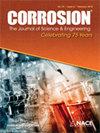镁合金腐蚀损失的双峰趋势
IF 1.1
4区 材料科学
Q4 MATERIALS SCIENCE, MULTIDISCIPLINARY
引用次数: 0
摘要
各种镁合金的质量损失与暴露期的函数关系数据表明,对于不同的暴露环境,腐蚀损失随时间呈双峰趋势,实验室和现场都支持这些发现。对于足以区分双模行为的数据集,第二种模式开始时的瞬时腐蚀速率是第一种模式结束时(即过渡时期)瞬时腐蚀速率的 4 倍(接近)。这一观察结果与理论上氧气和氢气通过腐蚀产物层的相对扩散率一致,因为它存在于过渡时期。这些发现支持了双模模型的观点,即在模式 1 中,腐蚀速率由阴极氧还原反应和氧的向内扩散控制,而在模式 2 中,腐蚀速率由阴极氢演化反应和氢的向外扩散控制。以前对各种铁合金和其他合金也有过类似的发现,因此对镁合金的腐蚀发展有了新的认识。它还提供了氢演化测量和电化学技术低估镁腐蚀速率的原因。此外,还提出了将这些方法结合起来的新程序。本文章由计算机程序翻译,如有差异,请以英文原文为准。
Bimodal trending in corrosion loss of magnesium alloys
Data for mass loss of a variety of magnesium alloys as a function of exposure period show that corrosion loss follows bimodal trending with time for different exposure environments, both laboratory and field support these findings. For data sets sufficient to discriminate bimodal behaviour, the instantaneous rate of corrosion at the commencement of the second mode is (close to) 4 times the instantaneous rate of corrosion at the end of the first mode (i.e. through the transition period). This observation is consistent with the theoretical relative diffusivities of oxygen and hydrogen through the corrosion product layer as it exists during the transition period. These findings support the notion that the bimodal model has corrosion in Mode 1 rate-controlled by the cathodic oxygen reduction reaction and the inward diffusion of oxygen while in Mode 2 corrosion is rate-controlled by the cathodic hydrogen evolution reaction and the outward diffusion of hydrogen. Similar findings have been made previously for various ferrous and other alloys and thus throws new light on the development of corrosion of magnesium alloys. It also provides reasons for measurements of hydrogen evolution and for electrochemical techniques underestimating magnesium corrosion rates. A new procedure for combining these is proposed.
求助全文
通过发布文献求助,成功后即可免费获取论文全文。
去求助
来源期刊

Corrosion
MATERIALS SCIENCE, MULTIDISCIPLINARY-METALLURGY & METALLURGICAL ENGINEERING
CiteScore
2.80
自引率
12.50%
发文量
97
审稿时长
3 months
期刊介绍:
CORROSION is the premier research journal featuring peer-reviewed technical articles from the world’s top researchers and provides a permanent record of progress in the science and technology of corrosion prevention and control. The scope of the journal includes the latest developments in areas of corrosion metallurgy, mechanisms, predictors, cracking (sulfide stress, stress corrosion, hydrogen-induced), passivation, and CO2 corrosion.
70+ years and over 7,100 peer-reviewed articles with advances in corrosion science and engineering have been published in CORROSION. The journal publishes seven article types – original articles, invited critical reviews, technical notes, corrosion communications fast-tracked for rapid publication, special research topic issues, research letters of yearly annual conference student poster sessions, and scientific investigations of field corrosion processes. CORROSION, the Journal of Science and Engineering, serves as an important communication platform for academics, researchers, technical libraries, and universities.
Articles considered for CORROSION should have significant permanent value and should accomplish at least one of the following objectives:
• Contribute awareness of corrosion phenomena,
• Advance understanding of fundamental process, and/or
• Further the knowledge of techniques and practices used to reduce corrosion.
 求助内容:
求助内容: 应助结果提醒方式:
应助结果提醒方式:


